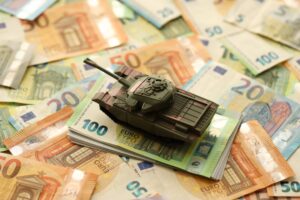In 2025, the debate over currency wars has resurfaced across global financial markets. Central banks are once again taking center stage, adjusting interest rates, deploying liquidity tools, and directly intervening in foreign exchange markets. Their goal is simple yet risky — to gain an export advantage through competitive devaluation while protecting domestic growth.
Although currency wars are not new, their modern dynamics are far more complex. In today’s hyperconnected economy, every monetary adjustment ripples instantly through financial systems. A single policy shift in one major economy can spark chain reactions in commodities, bond yields, and forex markets worldwide. With algorithmic trading and rapid data dissemination, the consequences of global currency policy changes now unfold in minutes rather than months.
The return of competitive devaluation reflects deeper tensions among economies trying to balance inflation control with trade competitiveness. Some nations are intentionally weakening their currencies to support exports, while others defend their exchange rates to maintain purchasing power. This divergence has made global markets more volatile and unpredictable.
This article examines how currency wars evolve in 2025, the early indicators of renewed devaluation cycles, and what traders, investors, and policymakers should prepare for. By analyzing the growing impact of currency devaluation on forex markets, we uncover how these hidden policy battles are quietly shaping global trade, inflation, and investment sentiment in the year ahead.
What Are Currency Wars and Why Do They Happen?
Currency wars describe a situation where countries deliberately devalue their currencies to gain economic advantages. When a country weakens its currency, its exports become cheaper and more competitive in global markets. However, this can provoke retaliation, leading to a cycle of competitive devaluation.
These actions disrupt global currency policy and cause market instability. As more central banks engage in currency manipulation, global trade imbalances and financial uncertainty increase. Historically, such periods have followed major crises or recessions, where governments seek to boost domestic growth through aggressive monetary policy.
Currency wars occur when international trade relationships are under stress or when economies face persistent deficits. A country may devalue its currency to stimulate demand for local goods and services, giving it an advantage on the global stage. However, this advantage is temporary, often prompting competing countries to respond with their own devaluations.
These devaluation strategies lead to a race to the bottom, where no country gains a long-term edge, and all participants face heightened economic instability. Moreover, investors lose trust in currency valuations, resulting in increased capital flight, reduced investments, and long-term harm to financial systems.
Are We Entering a New Cycle of Competitive Devaluation?
Several recent developments suggest a possible return to competitive devaluation. In the aftermath of pandemic stimulus and rising geopolitical tensions, inflation remains a global issue. To combat it, central banks are using a mix of interest rate hikes and foreign exchange interventions.
In 2025, countries like Japan, China, and even the United States are closely watching the strength of their currencies. The yen has dropped to multi-decade lows, while the dollar remains strong against emerging market currencies. These shifts hint at intentional or semi-intentional devaluation to boost export-driven recovery.
The current macroeconomic environment encourages competitive devaluation. With economic recovery lagging in several regions, policymakers are under pressure to revive growth. A cheaper currency acts as an economic stimulus without increasing government spending. Yet, this relief comes with side effects.
Central banks that push for weaker currencies risk triggering inflation. Imported goods become more expensive, squeezing consumers. At the same time, foreign investors may withdraw due to uncertainty, weakening the country’s financial position further. When many countries use this tactic simultaneously, the effects amplify.
The Forex Impact of Currency Devaluation on Traders
Currency wars significantly impact forex markets. When major currencies devalue, volatility increases. Traders experience unpredictable swings and sharp reversals, often outside of technical patterns. Sudden central bank actions or policy changes cause shockwaves that are difficult to price in.
For instance, when the Swiss National Bank removed the franc’s peg to the euro in 2015, it triggered massive losses. More recently, emerging market currencies like the Turkish lira and Argentine peso have experienced sharp declines due to government interference and devaluation fears.
The forex impact of currency devaluation often manifests in widened spreads, sharp liquidity gaps, and major re-pricing of currency pairs. Traders need to remain alert and factor in not just economic data, but also political strategy and central bank motives.
As currency values shift rapidly, technical analysis alone becomes less reliable. News-driven trades and fundamental analysis take precedence. Traders who understand macroeconomic policy and its timing gain an advantage. Watching interest rate decisions, inflation data, and central bank communications becomes critical.
Forex traders must also adapt their risk management strategies. Wider stop-losses and smaller position sizes help weather unexpected volatility. Advanced traders use options to hedge positions or shift toward pairs with lower correlation to impacted currencies.
How Central Bank Currency Manipulation Works
Central banks use several tools to influence their national currency. The most direct is through foreign exchange reserves. They buy or sell their own currency to influence its price. Another common approach is setting interest rate policy to attract or repel capital flows.
Central bank currency manipulation also involves verbal intervention. Simply hinting at rate changes or issuing warnings about currency levels can shift markets. This tactic is often used when direct action is politically sensitive or risky.
In 2025, we see coordinated or silent interventions, especially among Asian economies trying to remain competitive in exports. These actions, while sometimes legal, strain global currency policy cooperation and often trigger a race to the bottom.
Covert operations by central banks involve strategic timing. For example, announcements are made before markets open in key financial hubs to sway sentiment. Some institutions also collaborate with large domestic banks to execute bulk trades quietly. These measures reduce transparency and distort price discovery.
Currency manipulation also includes establishing ceilings or floors for exchange rates. Pegged currencies, like the Chinese yuan, offer less fluctuation but often involve state influence. This limits market-based valuation and creates distortions that can mislead traders and investors.
Historical Lessons from Past Currency Wars
Previous currency wars offer critical insight. The 1930s Great Depression era saw competitive devaluations that worsened the global downturn. More recently, the post-2008 environment led to unconventional monetary policies and growing resentment over strong versus weak currencies.
The U.S. accused China of currency manipulation for years, arguing that an artificially weak yuan distorted trade balances. In turn, other nations also sought to lower their currency values to stay competitive. The result was increased tariffs, trade conflicts, and market instability.
These historical patterns show that once a currency war starts, it rarely ends cleanly. Traders and investors must anticipate long-term instability and reduced trust in global economic coordination.
The 1971 Nixon Shock, when the U.S. ended the dollar’s gold convertibility, is another pivotal moment. It led to floating exchange rates and opened the door to competitive valuation. Since then, global economies have oscillated between free markets and manipulated currency policies.
Learning from the past, it is clear that currency wars escalate when trust in institutions declines. Weak global leadership, trade disputes, and diverging monetary policies often ignite the cycle.
Competitive Devaluation and the Role of Inflation
One of the key drivers of competitive devaluation is inflation. In a high-inflation environment, weaker currencies help increase exports but also raise import prices, leading to cost-push inflation. This complicates central bank goals.
For instance, if the euro weakens against the dollar, European goods become cheaper in the U.S., boosting exports. However, oil and imported goods become more expensive in the Eurozone. Central banks must then choose between fighting inflation or supporting the economy.
In 2025, inflation remains persistent due to supply chain shocks, energy price fluctuations, and post-pandemic recovery. As inflation pressures mount, central banks face increased temptation to devalue currencies subtly, fuelling the currency wars further.
Devaluation, however, offers only temporary relief. As input costs rise, profit margins shrink. Consumers face higher prices, lowering domestic demand. The inflation-devaluation loop can spiral unless policy actions are balanced.
This scenario creates a tightrope for policymakers. Aggressive rate cuts to weaken currency may trigger inflation surges, while failing to act may stall recovery. The interplay of inflation, interest rates, and devaluation defines modern monetary strategy.
The Global Currency Policy Dilemma
Global currency policy ideally promotes stability and fair competition. Institutions like the International Monetary Fund (IMF) and World Trade Organisation (WTO) aim to discourage competitive devaluation. However, enforcement is weak.
Each nation prioritises domestic goals. When one country gains an advantage by weakening its currency, others follow. The result is disjointed policy coordination and fractured trust. In such a world, currency wars become the default strategy, not the exception.
This creates a dilemma: should central banks support their own economies through manipulation or respect global stability norms? In reality, national interests usually win.
Despite global cooperation frameworks, the lack of penalties for manipulation leaves room for aggressive national policy. Surveillance and reporting mechanisms exist but lack teeth. As a result, global currency policy remains a recommendation, not a regulation.
Experts call for reforms that include stronger accountability, independent currency monitoring, and market-based penalties for habitual offenders. Until such frameworks are implemented, national interest will override collective responsibility.
How Traders Can Prepare for Currency Wars
For traders, currency wars present both risks and opportunities. The increased volatility can amplify gains but also magnify losses. Preparation is key. Traders should closely follow central bank meetings, policy statements, and unexpected interventions.
Risk management becomes more important than ever. Stop-loss placement, position sizing, and choosing liquid pairs are critical. Diversifying across currencies with different correlation levels can also reduce exposure.
Some traders may favour currency hedging or macro-driven strategies to align with broader trends. Understanding the fundamentals behind competitive devaluation allows traders to stay ahead of sharp moves rather than react to them.
Professional traders are also turning to macroeconomic indicators as part of their playbook. Monitoring inflation expectations, sovereign debt levels, and capital inflows helps anticipate currency shifts. Sentiment analysis tools, news aggregation platforms, and central bank briefings are becoming standard in trader toolkits.
In addition, automated risk control systems, including algorithmic trade alerts and trailing stop systems, help mitigate downside risk in fast-moving markets.
The Future of Currency Wars and Global Finance
Looking ahead, currency wars will likely remain a recurring theme. As economic competition grows and global cooperation wanes, central banks will continue to explore currency manipulation for strategic advantage.
The line between monetary policy and political influence will blur. Traders and institutions must become more agile, adaptive, and informed. Currency wars are no longer theoretical debates—they are active forces shaping forex markets daily.
Long-term solutions depend on renewed global dialogue, fair-trade enforcement, and central bank transparency. Until then, competitive devaluation will remain a tool in the global economic playbook.
Central banks must also enhance communication strategies. Clear policy signals help stabilise markets and prevent panic-driven reactions. Meanwhile, traders must continuously educate themselves, update their frameworks, and factor geopolitical motives into trade decisions.
Final Thoughts:
Currency wars create uncertainty, but also opportunity. Traders who understand the mechanics of competitive devaluation and central bank manipulation gain an edge. By focusing on fundamentals and market sentiment, they can thrive in unstable environments.
As the world teeters on another devaluation cycle, one thing is certain: those who prepare, observe, and adapt will survive the storm. The rest risk being swept away by the tide of aggressive monetary policy.
In 2025, the return of currency wars is not a question of “if” but “how soon and how far”.
Read here to learn more about “Impact of Trade Wars on Currency Markets in 2025 Explained“
Read here to learn more about “Smart Money Concepts in Forex: Real Strategies for Traders”

I’m Chaitali Sethi — a seasoned financial writer and strategist specializing in Forex trading, market behavior, and trader psychology. With a deep understanding of global markets and economic trends, I simplify complex financial concepts into clear, actionable insights that empower traders at every level. Whether it’s dissecting winning strategies, breaking down market sentiment, or helping traders build the right mindset, my content bridges the gap between information and implementation.




